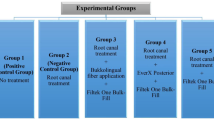Abstract
To determine the effect of resin based sealer on retention of casting cemented with three different luting agents. 55 extracted molar teeth were prepared with a flat occlusal surface, 20° taper and 4 mm axial height. The axial surface of each specimen was determined. The specimen were then distributed into five groups based on decreasing surface area, so each cementation group contained 11 specimens with similar mean axial surface area. A two-step, single bottle universal adhesive system (One-Step—Resinomer, Bisco) was used to seal dentin after the tooth preparation. Sealer was not used on the control specimens except for the modified-resin cement (Resinomer, Bisco) specimens that required use of adhesive with cementation. Using ceramometal (Wirobond®, BEGO), a casting was produced for each specimen and cemented with either zinc phosphate (Harvard), glass ionomer (Vivaglass) or modified resin cement (Resinomer) with single bottle adhesive. All the castings were cemented with a force of 20 kg. Castings were thermal cycled at 5 and 55 °C for 2,500 cycles and were then removed along the path of insertion using a universal testing machine at 0.5 mm/min. A single-factor ANOVA was used with a = 0.05. The nature of failure was also recorded. The mean stress removal for non sealed zinc phosphate, sealed zinc phosphate, non sealed glass ionomer, sealed glass ionomer and modified resin cement was found to be 3.56, 1.92, 2.40, 4.26, 6.95 MPa respectively. Zinc phosphate cement remained principally on the castings when the tooth surface was treated with the sealer and was found on both the tooth and the casting when the sealer was not used. Fracture of root before dislodgement was seen in 9 of 11 specimens with modified resin cement. Resin sealer decreases the retention of the castings when used with zinc phosphate and increases it when used with glass ionomer cement. The highest mean dislodgement force was measured with modified resin cement.







Similar content being viewed by others
References
Shillinberg HT Jr, Hobo Sumiya, Whitsett LD, Jacobi Richard, Brackette SE (1997) Fundamentals of fixed prosthodontics, 3rd edn. Quintessence Publishing Co. Inc., Chicago, pp 119–128
Rosenstiel SF, Land MF, Fujimoto J (2006) Contemporary fixed prosthodontics, 4th edn. Mosby Inc., St. Louis, pp 226–243
Tylman, Malone WF, Koth DL, Cavazos Edmund Jr, Kaiser DA, Margano SM (2001) Theory and practice of fixed prosthodontics, 8th edn. USA: Medicodental media international Inc., New York, pp 113–135
Addy M, Smith SR (2010) Dentin hypersensitivity: an overview on which to base tubule occlusion as a management concept. J Clin Dent 21:25–30
Walters PA (2005) Dentinal hypersensitivity: a review. J Contemp Dent Prac 15:107–117
Jacobsen PL, Bruce G (2001) Clinical dentin hypersensitivity: understanding the causes and prescribing a treatment. J Contemp Dent Prac 15(2):1–12
Watson TF, Flanagan D, Stone DG (2000) High and low torque handpieces: cutting dynamics, enamel cracking and tooth temperature. Br Dent J 188:680–686
Kern M, Kleimeier B, Schaller HG, Strub JR (1996) Clinical comparison of postoperative sensitivity for a glass ionomer and a zinc phosphate luting cement. J Prosthet Dent 75(2):159–162
Erdemir U, Yildiz E, Kilic I, Yucel T, Ozel S (2010) The efficacy of three desensitizing agents used to treat dentin hypersensitivity. J Am Dent Assoc 141(3):285–296
Yim NH, Rueggerberg FA, Caughman WF, Pashley DH (2000) Effect of dentine desensitizer and cementing agents on retention of full crowns using standardized crown preparation. J Prosthet Dent 83:459–465
Watanabe T, Sano M, Itoh K, Wakmotos (1991) The effect of primers on sensitivity of dentine. Dent Mater 7:148–150
Dondi dall’orologio G, Malferrari S (1993) Desensitizing effect of Gluma and Gluma 2000 on hypersensitive dentine. Am J Dent 6:283–286
Felton DA, Bergenholtz G, Kanoy BE (1991) Evaluation of desensitizing effect of Gluma dentine bond on teeth prepared for complete coverage restoration. Int. J Prosthodont 4:292–298
Bergenholtz G, Jontell M, Tuttle A, Knutson G (1993) Inhibition of serum albumin flux across exposed dentine following conditioning with Gluma primer, glutaraldehyde or potassium oxalate. J Dent 21:220–227
Pascal M, Tae HK, Domenico C, Terence ED (2005) Immediate dentin sealing improves bond strength of indirect restorations. J Prosthet Dent 94(6):511–519
Rosario PP, Glen HJ, Keith MP, Ariel JR (2006) Retention of zirconium oxide ceramic crowns with three types of cement. J Prosthet Dent 96(2):104–114
Pascal M, Woong-Seup S, Domenico C (2007) Immediate dentin sealing supports delayed restoration placement. J Prosthet Dent 98(3):166–174
Duygu S, Sinasi YS, Safak K, Tolga K (2005) Effect of the dentin cleansing techniques on dentin wetting and on the bond strength of a resin luting agent. J Prosthet Dent 94(4):363–369
Sillas Duarte Jr, de Freitas Claudia Regina Buanain, José Roberto Cury Saad, Sadan Avishai (2009) The effect of immediate dentin sealing on the marginal adaptation and bond strengths of total-etch and self-etch adhesives. J Prosthet Dent 102(1):1–9
Nordlander J, Weir D, Stoffer W, Ochi S (1988) The taper of clinical preparations for fixed prosthodontics. J Prosthet Dent 60:148–151
Kaufman EG, Coelho DH, Colin L (1961) Factors influencing the retention of cemented gold castings. J Prosthet Dent 11:487
Swift EJ, Lloyd AH, Felton DA (1997) The effect of resin desensitizing agents on crown retention. J Am Dent Assoc 128:195–200
Mausner IK, Goldstein GR, Georgescu M (1996) Effect of two dentinal desensitizing agents on the retention of complete cast coping using four cements. J Prosthet Dent 75:129–134
Johnson GH, Lepe X, Bales DJ (1998) Crown retention with use of a 5% glutaraldehyde sealer on prepared dentin. J Prosthet Dent 79:671–676
Author information
Authors and Affiliations
Corresponding author
Rights and permissions
About this article
Cite this article
Patel, P., Thummar, M., Shah, D. et al. Comparing the Effect of a Resin Based Sealer on Crown Retention for Three Types of Cements: An In Vitro Study. J Indian Prosthodont Soc 13, 308–314 (2013). https://doi.org/10.1007/s13191-013-0269-3
Received:
Accepted:
Published:
Issue Date:
DOI: https://doi.org/10.1007/s13191-013-0269-3




